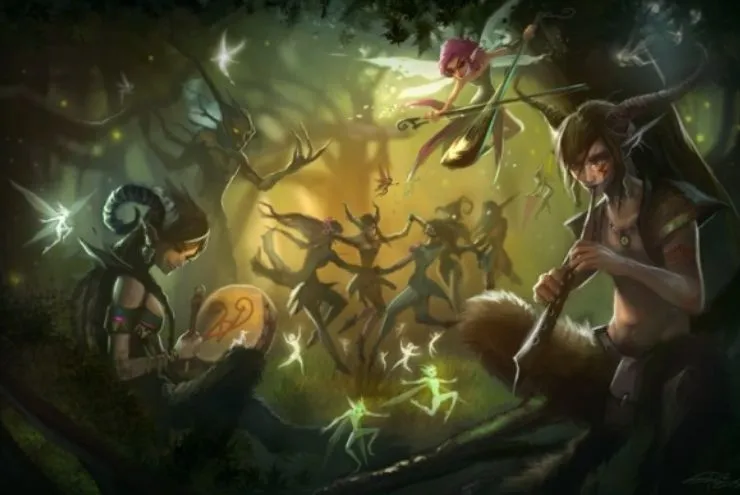A wanderer slouches on through the forest, struggling to keep the trail in sight and certain he should have reached the main road by now. But for days he’s heard faint laughter from behind nearby trees, found his boots laced together when he stands after a rest, and has somehow lost the trail more than once.
Two children playing in a field notice an elderly woman standing at the forest’s edge. She waves them closer with a smile, producing a few sweet treats from her pockets – but when they get too close, they find that they are treat about to be devoured.
All of these are examples of encounters with a broad category of strange, mystical beings with a stack of folklore behind them. With motives often stranger and more unpredictable than those of orcs, dragons or the more conventional creatures, they can add a different flavor to any game setting. Let’s talk about these diverse and magical creatures called Fey within DnD 5e.
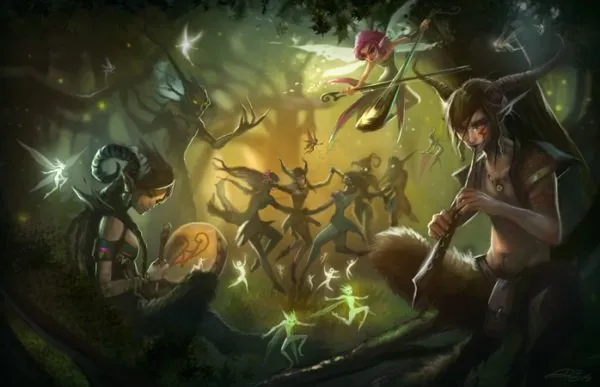
Fey Creatures in D&D 5E
In Dungeons and Dragons, fey creatures are defined as those magical creatures with a strong connection to nature, as well as to the magical parallel world known as the Feywild. They are distinctive for their almost alien nature, often unconcerned with conventional goals or wants and driven either by a love of whimsy, mischief, or sometimes darker ambitions.
A fey’s notion of a particular item’s value can seem bizarre, and their thinking often capricious and unpredictable. And many of them, including the darker varieties, can place a curious importance on deal-making – and show a maddening tendency to bend the definition of “honest deal” with various forms of trickery.
They most commonly reside in remote and wild areas, particularly those that have a touch of the mystical. Some, particularly the smaller varieties, can be much closer at hand, even sharing dwellings with unwitting human roommates. Their magic and other abilities is usually geared toward trickery, stealth, and nature.
That general template describes many “classic” fey, including brownies, pixie race, sprites, quicklings, and many more obscure variants. But fey creatures can come in a dizzying variety of shapes, sizes, and intentions.
Fey 5e Detailed List
Here’s just a short list of fey creatures in Fifth Edition, from the Monster Manual and Volo’s Guide to Monsters, to give an idea of the variety of creatures you can encounter under the umbrella of fey:
- Annis
- Boggle
- Korred
- Meenlock
- Redcap
- Sprite
Annis:
The Annis, or Black Hag, is the opposite of what most people think of as fey in virtually every respect – large (sometimes over 8’ tall), hideous, and completely evil. Annis hags are twisted, hunched creatures often with large (and seemingly misshapen) muscles – though some have been described as lean and spindly. Their skin is the blue-black of a deep bruise, their hair is jet black, and their eyes a sickly yellowish-green.
The nails of an Annis are literally an organic iron, which the Annis usually allows to grow out into vicious, twisted claws. As monstrous as their appearance already is, Annis hags delight in modifying their bodies to be even more terrifying, adding scars, grafting foreign objects (or creatures) onto themselves, or other perversities to cement their status as walking nightmares.
Annis hags can make three attacks per round – two claw attacks and a bite – and in a grapple they can deal a devastating crush attack. This, along with a resistance to damage from non-magical weapons, makes them dangerous foes in melee. Yet for all their physical prowess, they are much prefer to act through more indirect means.
The Annis can cast disguise self up to three times a day, taking the form of a medium-sized humanoid. They will use this to disguise themselves as anything from a harmless old woman to a lithe young maiden to venture among human and other populations and seek to sew distrust, tear communities apart with rumor and innuendo, and corrupt the innocent with guile and manipulation.
They are particularly fond of corrupting children, guiding them from minor mischief to increasingly malicious acts.
They also tend to leave various sorts of tokens about their territory – often grotesque fetishes made from their victims. The Annis delights in spreading fear and suspicion and enjoys nothing more than either rendering a whole community paralyzed with dread or causing it to rip itself apart with hatred and paranoia.
Annis Hags most commonly reside in caves or ruins of some kind. Rapacious meat-eaters, they are fond of the flesh of humans and demi-humans – and favor the flesh of children most of all. Their lairs are nightmarish places decked with the remnants both of their meals and of the crafts they make from their victims.
Boggle:
Standing about 3 feet tall, boggles are ugly, hairless creatures with dark blue or grey skin, a twisted posture, spindly arms and legs and a bulbous head with oddly and uniquely disproportionate features. They naturally excrete a non-flammable black ooze, which is often left behind as they move like a snail’s slime trail.
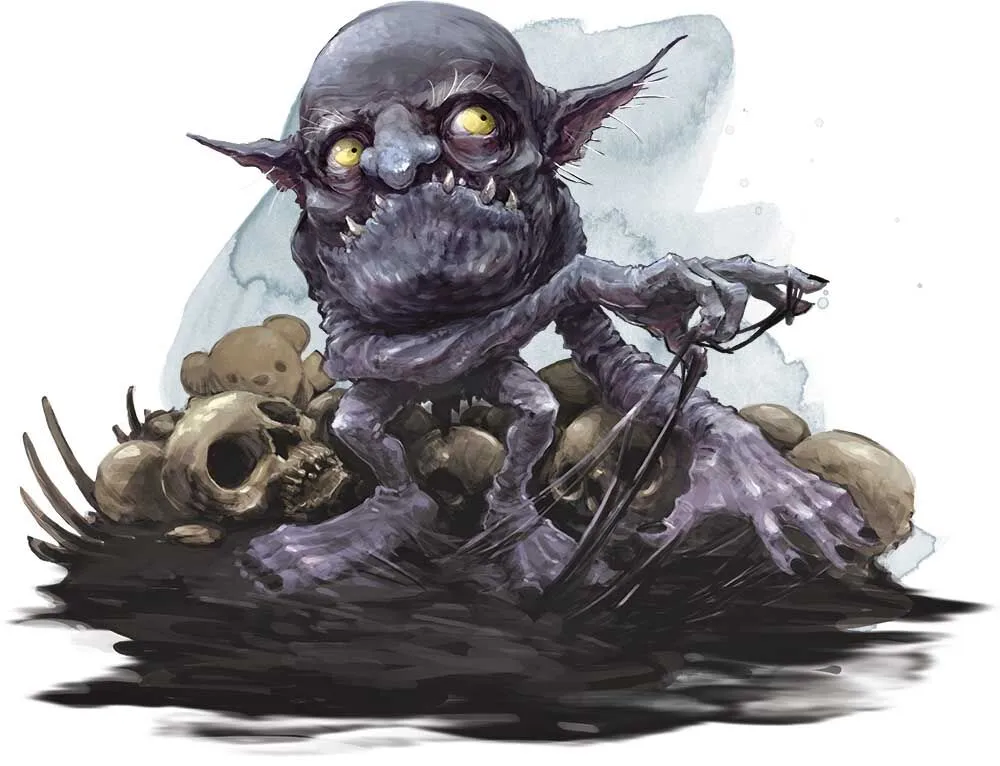
As a bonus action, the boggle can switch between a slippery and sticky version of this ooze – the slippery version gives him advantage on Dexterity (Acrobatics) checks to escape grapples, while the sticky ooze gives him advantage of Strength (Athletics) checks to grapple others and lets him climb walls and ceilings with no ability check required.
However, the boggle’s most formidable trick is the ability to create brief dimensional portals as a bonus action, using just about any complete opening (such as a door frame, window, hole in the wall, or even the side of legged piece of furniture, like a bed, so long as it creates a space bordered on all sides by some kind of solid object, not more than 10 feet on any one side).
These portals link to any point within 30 feet either within the boggle’s line of sight or a specific direction and distance away – 20 feet straight to the left, for example.
These portals last until the end of the boggle’s next turn, and only the boggle can utilize them. He can either travel through them or just see or reach through them, as desired.
Generally sly but cowardly, boggles are prone to annoying and mean-spirited pranks and in some cases can be genuinely malicious though this is rare. They can be commanded or befriended the powerful or charismatic, but their loyalty is generally brief and unreliable.
Korred:
Korred – These freewheeling creatures are short, squat fey creature with goat’s legs, gray skin, and – their most notable feature – long and dense beards and manes of hair, in both men and women. Korred can be quite vain about their hair, and they have reason to be.
Their hair is magical, takes on the properties of whatever material is used to cut it, and even after being cut from the head can still be controlled by the Korred up to 30’ away.
A standard practice of the korred is to carry iron shears both for a weapon and to cut their hair, leaving them with iron strands they weave together into ropes. A korred will always have at least one such iron-hair rope, at the usual 50’ length, which they can command (as a bonus action) to grapple their opponents within the 30’ range.
In addition to their shears, korred usually wield great clubs. Due to their strong connection to the earth, korred gain extra strength when standing in contact with the ground, great increasing their melee damage.
Korred also have a number of magical abilities that can make them challenging foes. They can cast stone shape, meld into stone, and commune with nature at will, and can cast conjure elemental (as a 6th level spell, allowing only earth elementals, galeb duhr, gargoyles or xorn) or Otto’s irresistible dance once per day.
For all their formidable abilities in combat, however, korred aren’t eager to engage in it. Secretive by nature, they are more likely to avoid other creatures, when possible, usually only seeking the company of their own kind or other earth-related fey creatures, like satyrs and dryads.
They are also known to tolerate the company of individuals of other races who respect nature (druids for example).
A korred’s primary interest is in revelry – they love dancing, music and feasting, and engage in them regularly. Interrupting their dancing is one of the few ways (aside from despoiling nature) to raise their ire.
Korred have a deep and inherent connection to the earth, so much so that they can sniff out mineral deposits and find their way through the most maze-like tunnels with ease. Those seeking deposits of particular gems or minerals will sometimes seek to enlist a korred, though the korred generally don’t care to be a part of such exploitive work.
Meenlock:
The meenlock is a horrific, vaguely insectoid fey creature born from shadows wherever intense fear is felt in either the Feywild itself or in fey-touched lands. Only about 2 feet tall, they are nonetheless dangerous, formidable creatures.
Meenlocks are normally found in the shadowed recesses of the forest where they dwell in burrows of twisting tunnels, hiding from the light of day – though they could also nest in sewers or other less-remote places daylight can’t reach. Once the sun sets, however, they go hunting for victims to terrify.
Meenlocks are powerfully telepathic, projecting an aura of fear on all creatures nearby. They love torturing creatures with nightmarish hallucinations, especially seeking out good or innocent creatures, as they detest anything related to goodness or light.
They attack with their powerful crab-like claws which have the added effect of potentially paralyzing the target. A victim incapacitated in this way will be dragged back to the meenlock’s burrow, where up to four of the creatures can psychically torment them, dealing psychic damage each hour until the victim reaches 0 hp.
Unfortunately, this doesn’t end in mere death. Rather, at this point the victim undergoes a warped transformation into a meenlock themselves in both mind and body, with no remnant of the person they’d been. Only a wish or the direct intervention of the divine can undo this terrible fate.
A meenlock can also teleport as a bonus action, traveling up to 30 feet to any dim or shadowed spot within range. They try to always stick to shadows, as they fight with disadvantage in any sort of bright light.
Redcap:
Likely the most bloodthirsty fey monster in D&D 5E, redcaps are evil fey creatures resembling small, wizened but very muscular old men, 3-4 feet tall, with heavy iron boots and a distinctive red cap. The cap is soaked in fresh blood and must remain so – if the blood on their caps is not replenished at least every three days, the redcap simply winks out of existence.
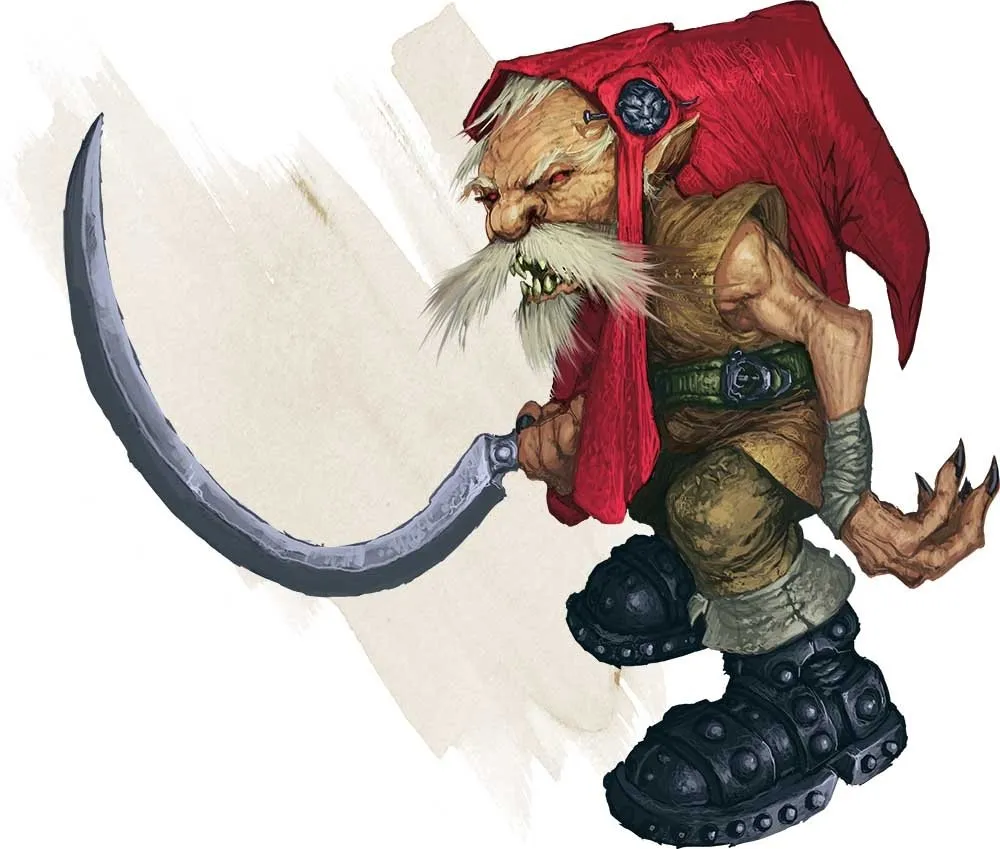
This means the redcaps must literally kill to survive, but that incentive is seldom needed. Created wherever blood is spilled on fey-touched soil – either in the fey realms themselves or at spots on the Material Plane which hold connections of some sort to the fey realms – they spring from the soil full formed and hungering for murder.
They iron boots redcaps wear give them disadvantage on stealth checks, but redcaps have no interest in being stealthy. They love the bloody chaos of direct melee, and charge at their chosen victim without hesitation.
Redcaps are surprisingly strong and fast (25’ speed) for their size, and while the iron boots make them easy to hear coming, they also give the redcap a brutal kick attack. They generally wield sickles and can make up to three attacks per round with them.
Fortunately, redcaps tend to be loners, and generally only one is encountered – though they can sometimes act in groups if they are serving a strong master. If slain, a redcap vanishes, leaving behind a single tooth which mages and the like covet for their supposed magical power, and especially the rumored ability to make the holder more charismatic to fey.
Sprite:
Unlike their more pacifist and playful cousins, the pixies, sprites are surprisingly fierce warriors considering their tiny size. They are similar to pixies in appearance – small elf-like humanoid fey with insect wings – though they are larger, standing about 2’ tall. And while pixies can have either butterfly or dragonfly wings (though usually butterfly), sprites universally have dragonfly wings.
If you are interested in pixies, be sure to read our article all about the 5E Pixie Race.
Sprites also carry themselves quite a bit more seriously than their cousins and many other fey, being much less likely to engage in the sorts of frivolity other fey devote themselves to. Rather they tend to be stern, judgmental, and militant – though they can still be a bit flighty, by non-fey standards.
They are keen judges of character, able to sense the emotions and alignments of others. They react harshly to invaders they judge to be morally lacking or otherwise untrustworthy, and they despise evil.
Sprites live in small villages often located in large tree trunks in secluded glens or near meadows. Unlike many fey, sprites tend to be more active in the daytime.
When they find themselves in combat, sprites use tiny-sized longswords and short bows, each doing only 1 hp. However, they offset this meager damage by being experts in the making of poisons and antidotes, and commonly use poisons on their arrows. They like to use sleep poisons in particular but are more than willing to upgrade to more lethal options for evil creatures.
Playing a Fey in D&D 5E
Previously – apart from a supplement to D&D Basic, released way back in 1989 – there were no options to play a fey character in D&D aside from homebrew options (and a brief bit of research would turn up dozens of such options for your DM to consider).
However, with the release of the latest 5E adventure, The Wild Beyond the Witchlight, there are now two new options for player races who have the fey type.
Fairy:
Designed to be versatile enough to be adapted to any one of many different cultural versions of fairy creatures from around the world, this catch-all version of the fey is a small-sized being with wings (usually – but not necessarily – insect-like).
Fairies receive a +2 which can be applied to any stat and an additional +1 which can be applied to another (or the player can choose to apply a +1 to each of three different stats). Having the fey type means they are immune to Charm, Hold Person, or Dominate (though you are subject to certain other spells, like hallow).
Their small size brings some limitations – they are at disadvantage with heavy weapons and cannot grapple large creatures. However, they can use medium-size animals as mounts, and are capable to moving through the space of creatures of Large size or bigger (treated as rough terrain).
They can fly, of course, at a speed matching that of walking (30 ft), so long as they are not wearing medium or heavy armor. This flight speed increases anytime walking speed increases, making them potentially the fastest-flying character race – with the right build (the monk, for example).
Fairies also have magical abilities – the druidcraft cantrip at 1st level, faerie fire at 3rd, and enlarge/reduce at 5th (these last two can be cast only once per long rest). The spellcasting trait can be either Intelligence, Wisdom or Charisma, at the player’s choice upon creation.
Harengon:
The Harengon is a bipedal rabbit-like creature, originally hailing from the Feywild but whose wanderlust has taken them to any number of worlds. They have the same modular stat block bonuses available to the Fairy and can be either small or medium as determined at character creation. Harengon have a speed of 30 feet and have a couple of interesting race-based abilities.
First, they can add their proficiency bonus to initiative rolls. This bonus does stack with feats that give bonuses to initiative (such as Alert), making it potentially a significant bonus.
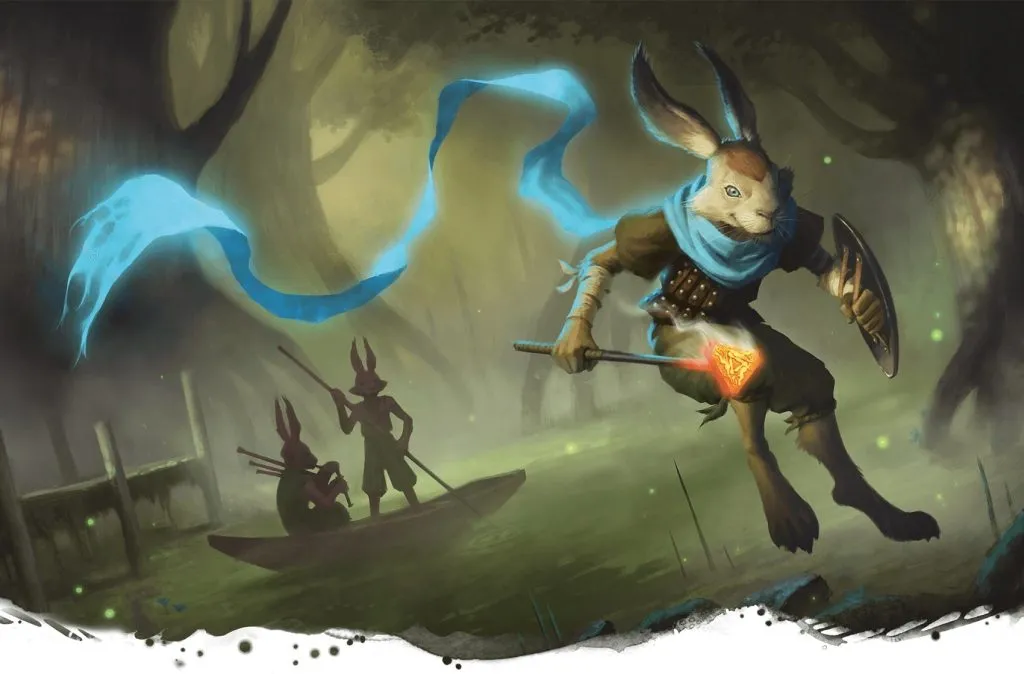
Secondly, Lucky Footwork allows the Harengon to use a reaction to add a d4 to DEX saving throws, and Rabbit Hop allows them to jump a distance of up to 5x their proficiency bonus in feet (which they can do a number of times equal to that bonus, per long rest). Jumping with Rabbit Hop does not provoke attacks of opportunity.
For players looking for an entirely new flavor of character, these two new races bring a welcome touch of magic. And they’re just one fact of the game additions in Wild Beyond the Witchlight, along with new background options (feylost and Witchlight hand), new fey-inspired character traits, and new creatures like the brigganock, the living doll, the giant snail, and D&D’s newest dragon, the Jabberwocky.
The Fey in Mythology
The fey (or, alternately, fay, fae, or fairy) originate from European stories, and come from a broad range of sources in folklore describing an even broader range of creatures. Anglo-Saxon, German, Norse, and obviously Celtic tales all contribute to the combined mythology we group under the term fairy today.
And while the English term fey is specific to Europe, the idea behind is far from unique. The notion of elusive magical creatures, usually small in size, who range from beneficial to prankish to sinister, is global.
Fey-like creatures appear in mythologies around the world, from Iceland’s elves, the duende of Spain and Portugal (and their New World colonies), the mogwai of China, the alux of the Yucatan, the jogah of the Iroquois, the Menehune of Hawaii, the Peri of Persian mythology and even the Zâne of ancient Rome, to name just a few.
So, what makes a fey a fey? Well, when most people think of a fey creature the term is generally taken to mean small or tiny creatures which have a mostly human-like appearance and possess magical powers used most commonly either to help or play tricks on humans.
But even restricting ourselves to European folklore, the possibilities go far beyond that. Sirens, banshees, goblins, leprechauns, and even trolls have all fallen under the term fey in folklore, as well as many less-familiar creatures. The motives and methods of the fey have been just as varied in the stories told about them.
The fey have been said to bring good luck, cause disease, kidnap children, do housework or other chores for the needy, cause milk to spoil or crops to fail, lead lost travelers to safety, and lead wanderers astray. They’ve been described as everything from tiny enough to sit on a thimble to roughly man-sized or even larger, and everything from beautiful to horrifying in appearance.
Fey 5e FAQ
Yes. Fey come in a range of alignments, though many tend toward chaotic neutral due to their free-spirited nature. Some fey, such as sprites, lean heavily toward good, while others like redcaps or meenlocks are unquestionably evil. But bear in mind even more neutral fey are mischievous by nature and often visit minor inconveniences on others as a prank – though how mean-spirited the pranks become depends largely on the target’s reactions.
Fey are a collection of magical creatures, widely varied in appearance, behavior, and alignment, who have a strong and magical connection to nature. They all tend to be elusive, staying largely hidden from the human world even as they interact with it, and often have seemingly bizarre motivations. They either hail from or are strongly connected to a magical plane of existence called the Feywild.
While strongly connected to nature and bearing an obvious resemblance to a number of fey creatures, Elves are not fey creatures themselves per se. They do, however, have a fey blood in their distant ancestry, which still grants them special abilities to this day.
There are various sorts of dark fey in 5E who are evil by nature, like the Annis. But like humans and demi-humans, most fey are at least capable of choosing an evil path, even if such alignments are rare for their particular species.
